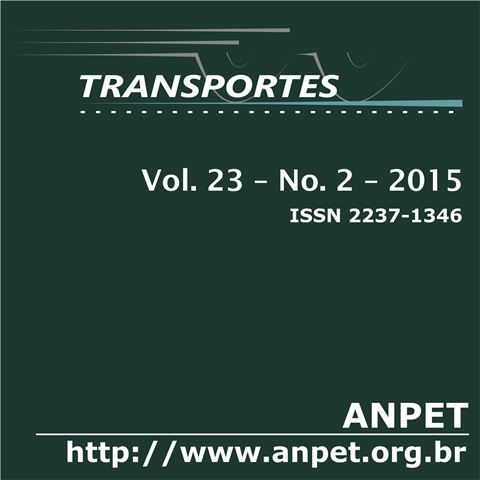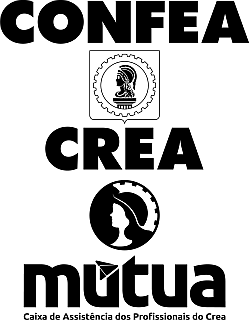Comportamento fluência-recuperação de ligantes asfálticos modificados com copolímero SBR e ácido polifosfórico
DOI:
https://doi.org/10.14295/transportes.v23i2.800Palavras-chave:
Ligantes asfálticos modificados, percentual de recuperação, compliância não-recuperável, copolímero SBR, ácido polifosfórico, grau de desempenho.Resumo
Este trabalho avaliou os comportamentos fluência-recuperação de ligantes asfálticos modificados com o copolí-mero SBR (CAP+SBR), ácido polifosfórico (CAP+PPA) e uma combinação de ambos (CAP+SBR+PPA) por meio do ensaio de fluência e de recuperação sob tensão múltipla (MSCR) em temperaturas entre 52 e 76 °C. Todas as formulações apresen-tam a mesma classificação em temperaturas altas (PG 76-xx) e o CAP 50/70 é classificado como PG 64-xx. Aumentos no percentual de recuperação (R) e reduções na compliância não-recuperável (Jnr) foram observados após os processos de mo-dificação, o que é favorável à resistência do CAP à deformação permanente. Os níveis recomendados de tráfego se mostraram semelhantes para o CAP+SBR+PPA e para o CAP+PPA, sendo também maiores do que aqueles encontrados para o CAP+SBR. Isto indica que o PPA tem potencial para substituir o uso do SBR na modificação do CAP, desde que a formulação não apresente uma suscetibilidade excessiva ao trincamento por fadiga e ao trincamento térmico.Downloads
Referências
AASHTO (2010) AASHTO MP19 – Standard Specification for Performance-Graded Asphalt Binder Using Multiple Stress Creep Recovery (MSCR) Test. American Association of State Highway and Transportation Officials, Washington.
Anderson, M. e J. Bukowski (2012) Using the Multiple-Stress-Creep-Recovery (MSCR) Test. Proceedings of the North Central Asphalt User Producer Group Meeting, Indianapolis, IN. Apresentação em PowerPoint. Disponível em: <http://engineering.purdue.edu/~ncaupg/Activities/2012/presentation%202012/
Anderson%20-%20MSCR%20AI%20NCAUPG%202012.pdf>. Acesso em: 14 out. 2014.
Anderson, R. M. (2011) Understanding the MSCR Test and its Use in the PG Asphalt Binder Specification. Asphalt Academy Webinars, Lexington, KY. Apresentação em PowerPoint. Disponível em: www.asphaltinstitute.org/dotAsset/48a2c0b0-d756-4b8c-913f-e7aaf91ef03d.pdf>. Acesso em: 14 out. 2014.
ASTM (2004) ASTM D2872 – Standard Test Method for Effect of Heat and Air on a Moving Film of Asphalt (Rolling Thin-Film Oven Test). American Society for Testing and Materials, West Conshohocken. DOI: 10.1520/D2872-04.
ASTM (2006) ASTM D5 – Standard Test Method for Penetration of Bituminous Materials. American Society for Testing and Materials, West Conshohocken. DOI: 10.1520/D0005-06.
ASTM (2006) ASTM D4402 – Standard Test Method for Viscosity Determination of Asphalt at Elevated Temperatures Using a Rotational Viscometer. American Society for Testing and Materials, West Conshohocken. DOI: 10.1520/D4402-06.
ASTM (2009) ASTM D36 – Standard Test Method for Softening Point of Bitumen (Ring-and-Ball Apparatus). American Society for Testing and Materials, West Conshohocken. DOI: 10.1520/D0036_D0036M-09.
ASTM (2010) ASTM D7405 – Standard Test Method for Multiple Stress Creep and Recovery (MSCR) of Asphalt Binder Using a Dynamic Shear Rheometer. American Society for Testing and Materials, West Conshohocken. DOI: 10.1520/D7405-10A.
Bahia, H. U (2014) Performance de Asfaltos Modificados com Polímeros. Anais do 21º. Encontro de Asfalto, Rio de Janeiro, RJ. Apresentação em PowerPoint.
Baumgardner, G. L (2012) Why and How of Polyphosphoric Acid Modification: An Industry Perspective. Transportation Research Circular, n. E-C160, p. 14-26.
Buncher, M. e J. A. D’Angelo (2012) Establishing a Baseline of Knowledge Through 2005 by Reviewing AI IS-220: Polyphosphoric Acid Modification of Asphalt. Transportation Research Circular, n. E-C160, p. 12-13.
D’Angelo, J. A (2009) The Relationship of the MSCR Test to Rutting. Road Materials and Pavement Design, v. 10, supl. 1, p. 61-80. DOI: 10.1080/14680629.2009.9690236.
D’Angelo, J (2010) New High-Temperature Binder Specification Using Multistress Creep and Recovery. Transportation Research Circular, n. E-C147, p. 1-13.
D’Angelo, J. e R. Dongré (2009) Practical Use of Multiple Stress Creep and Recovery Test: Characterization of Styrene-Butadiene-Styrene Dispersion and Other Additives in Polymer-Modified Asphalt Binders. Transportation Research Record, n. 2126, p. 73-82. DOI: 10.3141/2126-09.
D’Angelo, J.; R. Kluttz; R. Dongré; K. Stephens e L. Zanzotto (2007) Revision of the Superpave High Temperature Binder Specification: The Multiple Stress Creep Recovery Test. Journal of the Association of Asphalt Paving Technologists, v. 76, p. 123-162.
Dreessen, S.; J. P. Planche e V. Gardel (2009) A New Performance Related Test Method for Rutting Prediction: MSCRT. In: Loizos, A.; M. L. Partl; P. Scarpas e I. L. Al-Qadi (eds.) Advanced Testing and Characterization of Bituminous Materials. Leiden, The Netherlands. DOI: 10.1201/9780203092989.ch93.
Fee, D.; R. Maldonado; G. Reinke e H. Romagosa (2010) Polyphosphoric Acid Modification of Asphalt. Transportation Research Record, n. 2179, p. 49-57. DOI: 10.3141/2179-06.
Gierhart, D (2013) Multiple Stress Creep Recovery (MSCR): Why it Should be Implemented. Proceedings of the Louisiana Transportation Conference, Baton Rouge, LA. Apresentação em PowerPoint. Disponível em: <http://www.ltrc.lsu.edu/ltc_13/pdf/presentations/S43_Why%20the%20Multiple%20Stress%20Creep%20 Recovery%20(MSCR)%20Test%20Should%20be%20Implemen ted_LTC2013.pdf>. Acesso em: 14 out. 2014.
Leite, L. F. M (1999) Estudos de Preparo e Caracterização de Asfaltos Modificados por Polímero. Tese (Doutorado em Ciência e Tecnologia de Polímeros) – Instituto de Macromoléculas Professora Eloisa B. Mano, Universidade Federal do Rio de Janeiro, Rio de Janeiro.
Lesueur, D (2009) The Colloidal Structure of Bitumen: Consequences on the Rheology and on the Mechanisms of Bitumen Modification. Advances in Colloid and Interface Science, v. 45, n. 1-2, p. 42-82. DOI: 10.1016/j.cis.2008.08.011.
King, G.; H. King; R. D. Pavlovich; A. L. Epps e P. Kandhal (1999) Additives in Asphalt. Journal of the Association of Asphalt Paving Technologists, v. 68, p. 32-69.
Martins, A. T.; L. F. M. Leite; M. C. C. Cravo; M. Chacur; P. A. Pinto e D. F. Assumpção (2011) Fluência e Relaxação sob Múltiplas Tensões (MSCR): Avaliação do Desempenho de Ligantes Asfálticos. Anais do XVI CILA – Congresso Ibero-Latinoamericano do Asfalto, Clube de Ideias, Rio de Janeiro, v. 1, p. 711-721.
Masson, J.-F (2008) Brief Review of the Chemistry of Polyphosphoric Acid (PPA) and Bitumen. Energy & Fuels, v. 22, n. 4, p. 2637-2640. DOI: 10.1021/ef800120x.
Reinke, G (2010) Use of Hamburg Rut Testing Data to Validate the Use of Jnr as a Performance Parameter for High-Temperature Permanent Deformation. Transportation Research Circular, n. E-C147, p. 14-24.
Tam, K. K (2012) Polyphosphoric Acid-Modified Asphalt Cement: Ontario Perspective. Transportation Research Circular, n. E-C160, p. 109-114.
Yildirim, Y (2007) Polymer Modified Asphalt Binders. Construction and Building Materials, v. 21, n. 1, p. 66-72. DOI:
1016/j.conbuildmat.2005.07.007.
Zhang, F. e J. Yu (2010) The Research for High-Performance SBR Compound Modified Asphalt. Construction and Building Materials, v. 24, n. 3, p. 410-418. DOI: 10.1016/j.conbuildmat.2009.10.003.
Zhang, J.; J. Wang; Y. Wu; W. Sun e Y. Wang (2009) Thermal Behaviour and Improved Properties of SBR and SBR/Natural Bitumen Modified Bitumens. Iranian Polymer Journal, v. 18, n. 6, p. 465-478.
Zhang, J.; Y. Wu; J. Wang; Y. Wang e Y. Wang (2007). Improved Properties of Weathered Coal and SBR/Weathered Coal Compound Modified Asphalt. Iranian Polymer Journal, v. 16, n. 4, p. 251-259.
Downloads
Publicado
Como Citar
Edição
Seção
Licença
Ao submeter um manuscrito para publicação neste periódico, todos os seus autores concordam, antecipada e irrestritamente, com os seguintes termos:
- Os autores mantém os direitos autorais e concedem à Transportes o direito de primeira publicação do manuscrito, sem nenhum ônus financeiro, e abrem mão de qualquer outra remuneração pela sua publicação pela ANPET.
- Ao ser publicado pela Transportes, o manuscrito fica automaticamente licenciado sob a Licença Creative Commons CC BY 4.0. Esta licença permite o seu compartilhamento com reconhecimento da autoria e da publicação inicial neste periódico.
- Os autores têm autorização para assumir contratos adicionais separadamente, para distribuição não exclusiva da versão do trabalho publicada neste periódico (por ex.: publicar em repositório institucional ou como capítulo de livro), com reconhecimento da publicação inicial na Transportes, desde que tal contrato não implique num endosso do conteúdo do manuscrito ou do novo veículo pela ANPET.
- Os autores têm permissão e são estimulados a publicar e distribuir seu manuscrito online (por ex.: em repositórios institucionais ou na sua página pessoal) depois de concluído o processo editorial. Como a Transportes é de acesso livre, os autores são estimulados a usar links para o DOI do artigo nesses casos.
- Os autores garantem ter obtido a devida autorização dos seus empregadores para a transferência dos direitos nos termos deste acordo, caso esses empregadores possuam algum direito autoral sobre o manuscrito. Além disso, os autores assumem toda e qualquer responsabilidade sobre possíveis infrações ao direito autoral desses empregadores, isentando a ANPET e a Transportes de toda e qualquer responsabilidade neste sentido.
- Os autores assumem toda responsabilidade sobre o conteúdo do manuscrito, incluindo as devidas e necessárias autorizações para divulgação de dados coletados e resultados obtidos, isentando a ANPET e a Transportes de toda e qualquer responsabilidade neste sentido.









